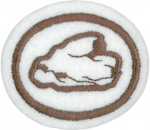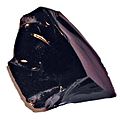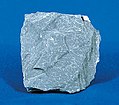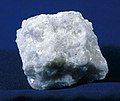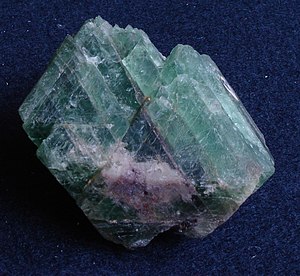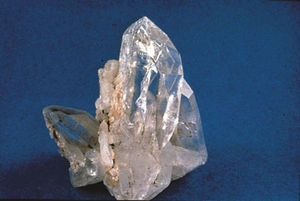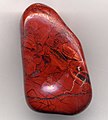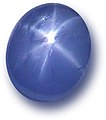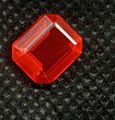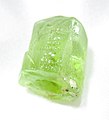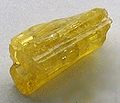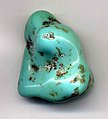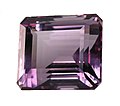Especialidades JA/Mineralogía/Respuestas
| Mineralogía | ||
|---|---|---|
| Asociación General
|
Destreza: 2 Año de introducción: 1937 |
|
Requisitos
|
La especialidad de Mineralogía es un componente de la Maestría Conservación. |
| Conexión Logros para la Investidura: Esta especialidad está relacionada con los requisitos de Logros para la Investidura para GUÍA Estudio de la Naturaleza que requiere (como una de dos opciones) coleccionar, obtener e identificar 15 diferentes clases de rocas y minerales que es similar al requisito #2 de esta especialidad. Esta especialidad es una elección popular para la especialidad de la categoría de Estudio de la naturaleza de nivel de destreza 2 o 3 requerido para los GUÍAS DE VIDA PRIMITIVA. |
1
Un mineral es un sólido inorgánico natural con una composición química definida y una estructura cristalina formada por procesos geológicos. Una roca es un agregado de uno o más minerales (una roca también puede incluir restos orgánicos y mineraloides). Algunas rocas están compuestas predominantemente de un solo mineral. Por ejemplo, la piedra caliza es una roca sedimentaria compuesta casi enteramente del mineral calcita. Otras rocas contienen muchos minerales y los minerales específicos en una roca pueden variar extensamente. Algunos minerales, como el cuarzo, mica o feldespato son comunes, mientras que otros se han encontrado en sólo uno o dos lugares en todo el mundo.
2
La identificación de rocas y minerales se hace más fácil con una guía de campo. Las siguientes propiedades son muy útiles para fines de identificación:
- Dureza
- Exfoliación
- Gravedad específica
- Lustre
- Color
- Raya
- Textura
- Estructura cristalina
Éstos se describen en detalle en los requisitos 4 y 5.
Necesitará unas cuantas herramientas para medir diversos aspectos de las rocas. No todos son necesarios, pero cuanto más de ellos estén disponibles, más exitoso será en identificar especímenes.
- Medidor de gravedad específica
- Azulejo de cerámica para determinar el color del «rasguño»
- Lupa
- Juego o equipo de dureza (puede usar lo siguiente como un juego de dureza como se explica en el requisito 4)
- Uña de la mano
- Moneda de cobre
- Hoja de cuchillo
- Cristal de ventana
- Lima de acero
3
3a
- Ígneas
- La roca ígnea se forma cuando la lava se enfría y se solidifica.
3b
- Sedimentaria
- La roca sedimentaria se forma cuando los sedimentos transportados por el viento o el agua se asientan y se convierten en piedra.
3c
- Metamórfica
- La roca metamórfica se forma cuando otro tipo de roca es transformado por gran calor y presión.
4
La escala Mohs de la dureza mineral caracteriza la resistencia al rayado de diversos minerales a través de la capacidad de un material más duro para rayar un material más blando. Fue creado en 1812 por el mineralogista alemán Friedrich Mohs y es una de varias definiciones de dureza en la ciencia de los materiales.
Mohs basó la escala en diez minerales que están todos disponibles. Como la sustancia conocida naturalmente más dura, el diamante está en la tapa de la escala. La dureza de un material se mide contra la escala encontrando el material más duro que el material dado puede rayar, y/o el material más blando que puede rayar el material dado. Por ejemplo, si algún material es rayado por la apatita pero no por la fluorita, su dureza en la escala de Mohs es 4.5.
La escala de Mohs es una escala puramente ordinal. Por ejemplo, el corindón (9) es dos veces más duro que el topacio (8), pero el diamante (10) casi cuatro veces más duro que el corindón. La tabla siguiente muestra la comparación con la dureza absoluta medida por un esclerómetro.
| Dureza | Mineral | Dureza absoluta |
|---|---|---|
| 1 | Talco
(Mg3Si4O10(OH)2) |
1 |
| 2 | Yeso (CaSO4·2H2O) | 2 |
| 3 | Calcita (CaCO3) | 9 |
| 4 | Fluorita (CaF2) | 21 |
| 5 | Apatita
(Ca5(PO4)3(OH-,Cl-,F-)) |
48 |
| 6 | Feldespato (KAlSi3O8) | 72 |
| 7 | Cuarzo (SiO2) | 100 |
| 8 | Topacio (Al2SiO4(OH-,F-)2) | 200 |
| 9 | Corindón (Al2O3) | 400 |
| 10 | Diamante (C) | 1500 |
En la escala de Mohs, la uña tiene dureza de 2.5; moneda de cobre, alrededor de 3.5; una cuchilla, 5.5; vidrio de ventana, 6.5; lima de acero, 6.5. Usar estos materiales ordinarios de dureza conocida puede ser una manera sencilla de aproximar la posición de un mineral en la escala.
A continuación se muestra una tabla alternativa que ha sido modificada para incorporar sustancias adicionales que pueden caer entre dos niveles.
| Dureza | Elemento o Mineral |
|---|---|
| 1 | Talco |
| 2 | Yeso |
| 2.5 a 3 | Oro y plata pura |
| 3 | Calcita, moneda de cobre |
| 4 | Fluorita |
| 4 a 4.5 | Platino |
| 4 a 5 | Hierro |
| 5 | Apatita |
| 6 | Ortoclasa |
| 6.5 | Pirita de hierro |
| 6 to 7 | Vidrio, sílice vítrea pura |
| 7 | Cuarzo |
| 7 a 7.5 | Granate |
| 7 a 8 | Acero reforzado |
| 8 | Topacio |
| 9 | Corindón |
| 10 | Diamante |
| 11.1 | Nanorods de diamante agregados |
5
Los términos que siguen tienen un significado específico en la mineralogía y son útiles para identificar el tipo de un espécimen de roca o mineral. Para al ojo no entrenado, una roca es una roca es una roca. Pero, si los siguientes términos se entienden, se anotan y se comparan con valores conocidos para varios especímenes, se puede hacer una identificación positiva.
5a
La exfoliación es la tendencia de los materiales cristalinos para dividirse a lo largo de planos estructurales cristalográficos definidos, de las cuales hay varios tipos nombrados:
- Exfoliación basal o hendidura pinacoidal: se produce en paralelo a la base de un cristal. La exfoliación basal es exhibida por el grupo de la mica y por el grafito, haciendo que el material se sienta resbalosa.
- Exfoliación cúbica: se produce en paralelo a las caras de un cubo de cristal con una simetría cúbica. Esta es la fuente de la forma cúbica visto en los cristales de halita y también de sal. La galena mineral también exhibe típicamente exfoliación cúbica perfecta.
- Exfoliación diagonal: es paralela a un plano vertical.
- Lateral cleavage: cleavage parallel to the lateral planes.
- Octahedral, Dodecahedral, or Rhombohedral cleavage: cleavage parallel to the faces of an octahedron, dodecahedron, or rhombohedron (respectively). Octahedral cleavage is seen in common semiconductors used in electronics.
- Prismatic cleavage, cleavage parallel to a vertical prism.
Cleavage is of technical importance in the electronics industry and in the cutting of gemstones. While precious stones are generally cleaved by impact, man-made single crystals of semiconductor materials are generally sold as thin wafers which are much easier to cleave. Simply pressing a silicon wafer against a soft surface and scratching its edge with a diamond scribe is usually enough to cause cleavage.
5b
Specific gravity is the ratio of the density of a material relative to the density of water. Density is the ratio of an object's mass to its volume. For instance, we know that 1 cm^3 of water weighs 1 gram. Therefore, the density of water is:
- [math]\displaystyle{ density_{water} = \frac{1 gram}{1 cm^3} = 1g/cm^3 }[/math]
A cubic centimeter of diamond would weigh 3.52 grams, so we can calculate the density of diamond as:
- [math]\displaystyle{ density_{diamond} = \frac{3.52 grams}{1 cm^3} = 3.52g/cm^3 }[/math]
Finally, we can calculate the specific gravity (G) of diamond:
- [math]\displaystyle{ G = \frac{density_{specimen}}{density_{water}} = \frac{3.52g/cm^3}{1g/cm^3} = 3.52 }[/math]
Division by 1 is a lovely thing!
What this really boils down to is that any given volume of diamond will weigh 3.52 times more than an equal volume of water. If you know the specific gravity, [math]\displaystyle{ G }[/math] of any material, you will know that it weighs [math]\displaystyle{ G }[/math] times an equal volume of water.
But what use is specific gravity? It helps us identify a mineral. We can measure a sample's specific gravity and compare it to the specific gravities of known specimens. To do this, we will need to make two measurements: the weight of the specimen, and its volume. Weight is easy (assuming you have a scale or a balance that can measure grams), but how do you measure the volume of an irregularly shaped specimen? All you need is some water, a drop of dish soap, and a graduated cylinder marked in metric units (note that 1 milliliter equals 1 cubic centimeter). Put some water in the cylinder, adding enough until the level comes to a convenient, well-marked level (such as 100 ml). Add a drop of dish soap to break the surface tension (you won't need more than a tiny drop). Then drop the specimen into the water and note the new water level. Subtracting the new level from the old will give you the volume of the specimen. Now all you need to do is divide the weight in grams by the volume in milliliters.
5c
Luster is a description of the way light interacts with the surface of a crystal, rock, or mineral. For example, a diamond is said to have an adamantine luster and pyrite is said to have a metallic luster.
Other descriptive terms used for gems include vitreous, like glass; resinous, like amber; waxy, like jade; greasy, like soapstone; pearly; and silky.
5d
Color indicates the appearance of the mineral in reflected light (for opaque specimens) or transmitted light (for translucent specimens). In other words, it means just what you would think it means - what it looks like to the naked eye. Before noting the color of a specimen, it is important to clean it off.
5e
The streak (also called powder color) of a mineral is the color of the powder produced when it is dragged across an unweathered surface. Unlike the apparent color of a mineral, which for most minerals can vary considerably, the trail of finely ground powder generally has a more consistent characteristic color, and is thus an important diagnostic tool in mineral identification. If no streak seems to be made, the mineral's streak is said to be white or colorless. Streak is particularly important as a diagnostic for opaque and colored materials. It is less useful for silicates, most of which have a white streak and are too hard to powder easily.
The apparent color can vary widely because of trace impurities or a disturbed macroscopic crystal structure. Small amounts of an impurity that strongly absorbs a particular wavelength can radically change the wavelengths of light that are reflected by the specimen, and thus change the apparent color. However, when the specimen is dragged to produce a streak, it is broken into randomly oriented microscopic crystals, and small impurities do not greatly affect the absorption of light.
The surface across which the mineral is dragged is called a "streak plate," and is generally made of unglazed porcelain tile. In the absence of a streak plate, the underside of a porcelain bowl or vase, the surface of an electrical fuse, or the back of a glazed tile will work. Sometimes a streak is more easily or accurately described by comparing it with the "streak" made by another streak plate.
Because the trail left behind results from the mineral being crushed into powder, a streak can only be made of minerals softer than the streak plate, around 7 on the Mohs scale of mineral hardness. In this case, the color of the powder can be determined by filing or crushing with a hammer a small sample, which is then usually rubbed on a streak plate. Most minerals that are harder have an unhelpful white streak.
Some minerals leave a streak similar to their natural color, such as cinnabar and azurite. Other minerals leave surprising colors, such as fluorite, which always has a white streak, although it can appear in purple, blue, yellow, or green crystals. Hematite, which is black in appearance, leaves a red streak which accounts for its name, which comes from the Greek word "haima," meaning "blood." Galena, which can be similar in appearance to hematite, is easily distinguished by its gray streak.
5f
Texture in geology refers to the physical appearance or character of a rock, such as grain size, shape, and arrangement, both to the naked eye and under a microscope.
5g
A crystal is a solid whose atoms, molecules, or ions are packed in a regularly ordered, repeating pattern extending in all three spatial dimensions. Snowflakes, diamonds, and common salt are common examples of crystals.
6
Uses for Rock
- Building material
- Gravel
- Paving stones
- Grinding grain into meal (millstones)
- Sharpening blades (whetstones)
- Sculpture medium (marble, granite, others)
- Fill material
- Fuel (coal)
- Ores (most metals are extracted from ore)
Uses for Minerals
- Abrasives (diamond dust, garnet, others)
- Lasers (sapphire, ruby)
- Electronics (semiconductors)
- Lenses (quartz)
- Nutrition (your body needs many minerals)
- Traction (silica - also known as sand)
- Currency (gold, silver, copper)
- Pencil lead (graphite)
- Lubricant (graphite)
- Medicine (Kaopectate is made from the mineral kaolin)
7
- Exodus 24:16-18
- God carves the ten commandments in stone.
- Numbers 20:2-13
- God commands Moses to speak to the rock to provide water for the Israelites but Moses hits it instead.
- 1 Samuel 17
- David kills Goliath with a stone.
- Daniel 2:34
- A stone is cut without hands and destroys the image in Nebuchadnezzar's dream.
- John 11:38-44
- Jesus orders that the stone covering the tomb of Lazarus be removed.
- Matthew 7:24-29
- The parable of the wise and foolish builders.
- Acts 6-7
- The stoning of Stephen.
8
Revelation 21:19,20 describes the foundation stones of the New Jerusalem.
The wall has twelve foundation stones, and on these are written the names of the Twelve Apostles. Revelation lacks a list of the names of the Twelve Apostles, and does not describe which name is inscribed on which foundation stone, or if all of the names are inscribed on all of the foundation stones, so that aspect of the arrangement is open to speculation. One scholar hold that Judas Iscariot's name is absent from the foundations, replaced by that of another Apostle.
These foundation stones are adorned with twelve types of precious stones. In modern times, the precise identification of all these precious stones is not certain, as several of the ancient names may refer to several different types of stones, or may no longer refer to the same kinds of stones that they did at the time of Revelation's writing. Also, the layout of the precious stones is contested. All of the precious stones could adorn each foundation stone, either in layers or mixed together some other way, or just one unique type of stone could adorn each separate foundation stone.
References
Wikipedia Articles
- Categoría: Tiene imagen de insignia
- Adventist Youth Honors Answer Book/Honors/es
- Adventist Youth Honors Answer Book/es
- Adventist Youth Honors Answer Book/Skill Level 2/es
- Categoría: Libro de respuestas de especialidades JA/Especialidades introducidas en 1937
- Adventist Youth Honors Answer Book/General Conference/es
- Adventist Youth Honors Answer Book/Nature/es
- Adventist Youth Honors Answer Book/Stage 100/es
- Adventist Youth Honors Answer Book/Conservation Master Award/es
- Adventist Youth Honors Answer Book/IAConnection/es
- Adventist Youth Honors Answer Book
